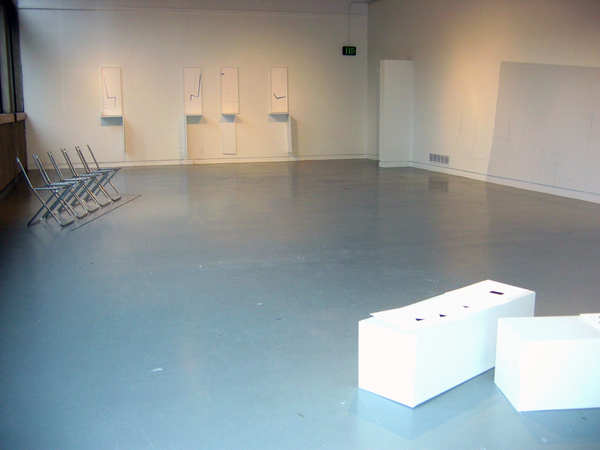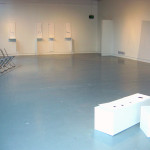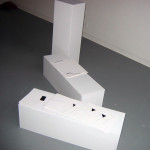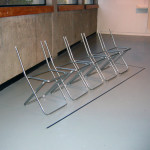By MICAH J. MALONE
The sparse and poetic work of Avantika Bawa seems at once both subtle and authoritative. "Sit/Stack", the title of her exhibition at Portland State University's Autzen Gallery, came to me like a command, a forceful voice telling viewers what to do. However, the voice of a poet emerges from her use of drawing and its relationship to three-dimensional space. Indeed, the very paradox that separates these disciplines serves to find the forever-existing gap that divides them.
Walking into the gallery, one is met with a series of drawings scattered on upended pedestals. Each drawing is of a chair, more or less in perspective, although the imperfections in the vanishing points makes these works distinct from architectural or design drawings. The repetitive nature of the work allows certain elements to be accentuated and others subdued. In one, we see the legs extended, another shortened. In a sense, we are seeing the same chair from a different vantage point. Yet this perspective begins to feed into one's sense of physical space as well. After looking at the drawings, I noticed that the random display of pedestals in which the drawings rest on, actually forms a similar shape to the chairs.
It is this slip from the two-dimensional world of drawing into the "real" world of three dimensions that drives Bawa's exhibition. The French engineer Charles de Freycinet, whose book Of Experience in Geometry might best describe the type of abstraction that occurs in Bawa's work: the substitution of line and surface for mass or volume. If volume is that portion of space occupied by a body, a concrete representation "replaced by a very thin envelope which exactly reproduces the exterior form," for Freycinet then, the first abstraction in geometry is a body retiring its own material, leaving only the place it occupies in space. This "place" is the ideal form - a "being of reason".
It is this "reason" that drives much of modernity and its "rational" forms. Bawa's Ikea chairs seem to illustrate this most clearly. The clean lines and rational succession (one chair after another...) show not only the clarity of these modern forms, but their ultimate dependence on drawing to be brought into the "real" dimensional world. However, it is Bawa's intervention that heightens their rationality. The removal of the chair's "skin", the seat and back, show just how much the form is based on drawing and geometry, but also, how the chair itself is a structure in which the form reproduces the exterior of the body, an imprint of a sitting body.
No other discipline is based closer to geometry than drawing. Despite the many applications in the real world, geometry is an analysis of abstract entities best conceived in ideal space and on paper. This is the precise paradox so wonderfully explored by Darcy Grimaldo Grigsby, and it is also this paradox that makes Bawa's work so poignant. Hung on the far wall of the gallery are a series of framed chair drawings. Below them are built elements that reflect the clean, precise lines of the chair drawings, but also double as chairs or shelves in their own right, making the slippage between two and three dimensions endlessly circular. The doubling these elements perform show how closely related the two and three-dimensional worlds of drawing and real space are, furthering the paradox that these fields will always possess.
- Avantika Bawa, installation from Sit, Stack.
- Avantika Bawa, Untitled Chair drawings, Acrylic and Graphite on paper, dimensions vary, 2007.
- Avantika Bawa, Sit, Jeff, Ikea chairs and tape, 2007.
Portland State University
Tilt Gallery
"Sit, Stack" was on view from November 3 through November 29 at Autzen Gallery at Portland State University.
All images are courtesy of the artist and Autzen Gallery.







